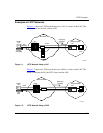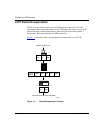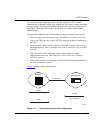
Configuring L2TP Services
1-6
303532-A Rev 00
L2TP Network Server (LNS)
The L2TP network server (LNS) is a router that resides at the corporate network
and serves as the termination point for L2TP tunnels and sessions.
The LNS authenticates the PPP connection request and allows the end-to-end PPP
tunneled connection. The LNS may also perform user authentication with a
RADIUS server to prevent unauthorized users from accessing the network;
however, user authentication may also be done by the LNS itself.
An LNS can support multiple remote users, each communicating within their own
L2TP session. The L2TP session is the virtual end-to-end connection over which
the LAC sends data to the LNS.
The Bay Networks router is an LNS. For information about the Bay Networks
LNS, see “Bay Networks L2TP Implementation
” on page 1-11.
RADIUS Server
An L2TP network may include a Remote Authentication Dial-in User Service
(RADIUS) server. The RADIUS server has three main functions in an L2TP
network:
• Authenticating the remote users
• Assigning IP addresses to the remote users
• Providing accounting services for corporate billing
The RADIUS server database centralizes the authentication function, eliminating
the need to configure each LNS with user names and passwords. It also assigns an
IP address to a remote host to identify the host. Finally, the RADIUS server can
provide accounting services for the corporate network, calculating billing charges
for an L2TP session.
For information about the Bay Networks implementation of RADIUS user
authentication and accounting, see “RADIUS User Authentication
” on page 1-14
and “RADIUS Accounting” on page 1-15.


















